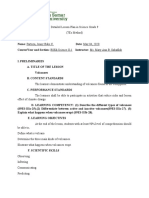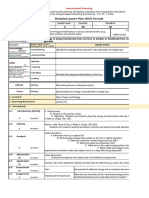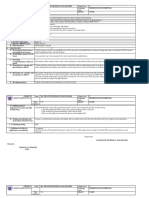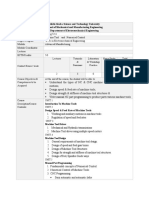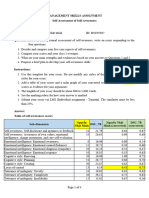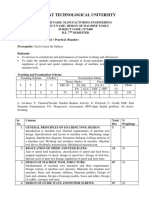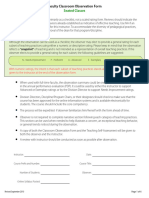AD L P Grade 9 Science: Etailed Esson LAN IN 1 Session March, 2015 I. O
AD L P Grade 9 Science: Etailed Esson LAN IN 1 Session March, 2015 I. O
Uploaded by
AndrewdKiatKiatCopyright:
Available Formats
AD L P Grade 9 Science: Etailed Esson LAN IN 1 Session March, 2015 I. O
AD L P Grade 9 Science: Etailed Esson LAN IN 1 Session March, 2015 I. O
Uploaded by
AndrewdKiatKiatOriginal Description:
Original Title
Copyright
Available Formats
Share this document
Did you find this document useful?
Is this content inappropriate?
Copyright:
Available Formats
AD L P Grade 9 Science: Etailed Esson LAN IN 1 Session March, 2015 I. O
AD L P Grade 9 Science: Etailed Esson LAN IN 1 Session March, 2015 I. O
Uploaded by
AndrewdKiatKiatCopyright:
Available Formats
DON MARIANO MARCOS MEMORIAL STATE UNIVERSITY
A DETAILED LESSON PLAN
South La Union Campus
COLLEGE OF EDUCATION
IN
Agoo, La Union
Time Frame :
Date
:
I.
GRADE 9 Science
1 Session
March, 2015
OBJECTIVES:
At the end of the lesson, the students should be to:
1. Differentiate heat, internal energy, and temperature
2. Explain the first law of thermodynamics
3. Appreciate the applications of the first law of thermodynamics
II.
SUBJECT MATTER:
A.
B.
C.
D.
Topic
Sub-Topic/s
Materials
References
:
:
:
First law of Thermodynamics
:
Internal energy, heat, and temperature
Instructional materials, writing materials
Giancoli, Douglas, C. (2014). Physics Principles with
Applications Textbook. United States: Pearson
Education Inc.
E. Skills Developed
F. Values Integrated
III.
:
:
analysis, logical thinking
accuracy, discipline, attentiveness, persistence
PROCEDURE:
Teachers Activity
A. Routinary Activities
1. Prayer
Class who will lead the prayer for
today?
Ok miss, please come here in front
and lead the prayer.
2. Greetings
Good morning!
3. Classroom Management
Go back to your proper seats and
kindly pick up the pieces of paper
under your chairs. Those who are
not in their proper places will be
marked absent.
Learners Activity
B. Review
From the past discussions, you
learned the different forms of energy,
right?
Can you give me examples of the
different forms of energy?
Yes Sir!
-sir!
-(praying)
-Good morning Sir!
- (moving back to their proper places)
- (picking up the pieces of paper)
-sir
-sir
-sir
-sir
-sir
chemical energy!
mechanical energy!
heat energy
kinetic energy
potential energy
-yes sir!
All of those are correct. You also
learned that how to compute work,
using force right?
Yes but today we might be able to
find another way to compute work,
without using force.
We is it only force that can make
matter do work?
We will be able to answer that
question as we go on with our topic.
But first, let me show you a simple
1
-
-
ACCELERATION
JUSTINE P. LAUS
DON MARIANO MARCOS MEMORIAL STATE UNIVERSITY
South La Union Campus
COLLEGE OF EDUCATION
A DETAILED LESSON PLAN
IN
Agoo, La Union
and short experiment.
Teachers Activity
GRADE 9 Science
Learners Activity
ACCELERATION
JUSTINE P. LAUS
DON MARIANO MARCOS MEMORIAL STATE UNIVERSITY
South La Union Campus
COLLEGE OF EDUCATION
A DETAILED LESSON PLAN
IN
Agoo, La Union
C. Motivation
Since we are studying energy, let
me show you a short experiment that
will let you have an idea about the
laws of thermodynamics. I have her a
soft drinks can with an open moth on
the one end. Now let us punch a tiny
hole on the opposite end. Lets try to
cover the open mouth with a piece of
paper and tie it with a rubber band.
After that, lets put few drops of
alcohol inside the can using a dropper
(tiny enough to fit the hole that we
made earlier). Now, I will apply heat
on the tiny hole of the can. Observe
what will happen.
(performing the experiment)
What did you observe?
Yes very good observation. In this
short experiment, we are able to show
the first law of thermodynamics.
Anyway, what factors do you think is
the reason why the paper was blown
away?
Correct! What else?
Ok! Very good! What else?
Another factor here is the one
called internal energy.
D. Presentation
Are you familiar with the term
internal energy? What comes into
your mind when you hear the word
internal energy?
Yes thats a very good idea. What
else?
Okay! Internal energy in books, is
defined as the total energy inside a
body or a system.
Do you believe that molecules and
atoms are moving?
How did you say so?
There is a theory called kinetic
molecular theory that tells us that
molecules and atoms are moving. But
how can we prove that? How can we
say that molecules and atoms are
moving when we are not even
capable of seeing them?
Okay! During day time, have you
ever experienced looking at the flash
of sunlight in from your windows while
you are cleaning?
You can see the dusts right?
How can
you describe the
movement of those dust?
GRADE 9 Science
- Sir the paper was blown away!
-Sir Heat!
-Temperature sir!
-
-Energy inside a body sir
-
-yes sir!
-
-
-yes sir!
-yes sir
-sir there seem like dancing
moving in random directions!
while
-Its the air sir!
-yes sir!
-yes sir!
Correct! What do you think is the
one that drives them to move like
that?
Yes and the air is made up of
molecules and atoms, right?
The fact that the air made the
3
ACCELERATION
JUSTINE P. LAUS
DON MARIANO MARCOS MEMORIAL STATE UNIVERSITY
South La Union Campus
COLLEGE OF EDUCATION
A DETAILED LESSON PLAN
IN
Agoo, La Union
dusts move in random directions,
means that the molecules of air is
also moving! Am I right?
Still not convinced? Lets try to
prove it in liquids. I will pour food
color in this glass of water and
observe.
Teachers Activity
GRADE 9 Science
Learners Activity
ACCELERATION
JUSTINE P. LAUS
DON MARIANO MARCOS MEMORIAL STATE UNIVERSITY
South La Union Campus
COLLEGE OF EDUCATION
A DETAILED LESSON PLAN
IN
Agoo, La Union
(Performing the experiment)
Ok! What did you observe?
How? How can you describe the
movement of the food coloring
particles?
Yes! Very good. What do you think
is the one who made the food coloring
particles scatter?
Precisely! Water this proves us
again that water molecules are
moving.
Now are you convinced already?
You already know that molecules
and atoms in an object is moving.
They
are
moving
in
random
directions. It either rotating, vibrating
or translating. Now can you tell me
what kind of energy does this
molecules and atoms have?
Very good! Now if somebody asked
you, how fast the molecules in this
object are moving, what will you say?
How will you describe it? Can you tell
them the exact kinetic energy of each
individual molecule? No you cant
right? Its impossible to do that. But
you can tell them the average kinetic
energy of individual molecules in an
object. And that is temperature!
Temperature can tell us how fast
these molecules are moving.
I have here a chalk. This is a
system, or a body. It is composed of
atoms and molecules. The total or the
sum of all the energy with in this
chalk is called internal energy. Did
you get it?
Question: can we measure internal
energy?
No we cant. But if we cant
measure it then how can we even say
that it exists?
For example this object. Does this
object have temperature?
Yes! The fact that it has
temperature surely means that it also
have
internal
energy!
Since
temperature tells us the average
kinetic energy and the total of that
energy is internal energy.
Do you understand class?
How about ice? Do ice have
internal energy?
Yes
they
have.
The
low
temperature only means that the
molecules on that body is just moving
slow. Still there is internal energy.
Basically, the colder the object, the
lower the temperature, and the
slower the molecules are moving. The
hotter the object, the higher the
temperature, and the faster there are
5
GRADE 9 Science
-sir the food coloring was dissolved.
-sir it was somewhat dispersed!
-water sir!
-yes sir!
-sir kinetic energy!
-yes sir!
-
-
-yes sir!
-Yes sir!
-Yes sir!
-sir hot water
-sir the beaker will become hotter.
ACCELERATION
JUSTINE P. LAUS
DON MARIANO MARCOS MEMORIAL STATE UNIVERSITY
South La Union Campus
COLLEGE OF EDUCATION
A DETAILED LESSON PLAN
IN
Agoo, La Union
moving.
Now, I have here two objects; hot
water, and a beaker. Which has higher
temperature?
Hot water? Or the
beaker?
Very good! It means that the
molecules of object A. are moving
faster than the molecules of Object B.
If that is so, then what do you think
will happen if we put them in contact?
Teachers Activity
GRADE 9 Science
Learners Activity
ACCELERATION
JUSTINE P. LAUS
DON MARIANO MARCOS MEMORIAL STATE UNIVERSITY
South La Union Campus
COLLEGE OF EDUCATION
A DETAILED LESSON PLAN
IN
Agoo, La Union
Correct! Why did it become hotter?
What happened? Actually class,
since the molecules of object-A are
moving faster than the molecules of
object-B, the energy was transferred
from object-A to B. How can we prove
that? I have here a vibrating
cellphone, if I will put this in your desk
like this.
(placing the phone on 1 students
desk)
What do you think will happen to
the desk?
Correct! That is the same in our
example earlier. If an object whose
molecules are moving so fast made a
contact with an object whose
molecules are slower. What will
happen?
Precisely. The energy will transfer.
So basically, when we put an object of
higher temperature together with an
object of lower temperature. Energy
will transfer. The energy that was
removed from object-A, and the same
energy that was accepted by object-B
is called heat. Heat is the energy in
transfer. Heat can be produced when
there is a difference in temperature.
Question: By the time that object B
absorbed the heat. Can you still call it
heat?
Then how will you call it?
By time it was absorbed by objectB, it is already part of the internal
energy of that Object! It is no longer
heat, it is already part of the internal
energy of object B.
You can only call it heat while it is
in transfer. You can think about it like
this. Water in rivers flow onto the sea,
but once it is already in the sea, will
you still call it river water?
Correct, because it is already part
of the sea! That is the same with
heat. Once it was already absorbed
by an object, it is already part of the
internal energy of that object.
When heat is added or removed
from an object. Internal energy
changes. Correct?
When doing so, work may be done
on the system or by the system. For
example, our experiment earlier, our
system is the can with paper cover.
We added heat to that system. And
then what happened?
Correct! Therefore, work is done
by the system. If we will put that into
an equation, we will have U=Q-W.
The change in internal energy, is
equal to the heat added, minus the
7
GRADE 9 Science
-it will also vibrate sir!
-the slower
faster!
molecules
will
become
-No sir!
-
-no sir!
-yes sir!
-Sir the paper was blown away!
-yes sir!
ACCELERATION
JUSTINE P. LAUS
DON MARIANO MARCOS MEMORIAL STATE UNIVERSITY
South La Union Campus
COLLEGE OF EDUCATION
A DETAILED LESSON PLAN
IN
Agoo, La Union
work done by the system. This means
that when we add heat to a system,
we change its internal energy, and
that change is used to do work! What
if work is done on the system? Lets
say for example, we have here a cup
of water, if we stir it, we do work on it.
Right?
By doing so! We are also
increasing the speed of the molecules
and that is the as increasing the
temperature.
Teachers Activity
GRADE 9 Science
Learners Activity
ACCELERATION
JUSTINE P. LAUS
DON MARIANO MARCOS MEMORIAL STATE UNIVERSITY
South La Union Campus
COLLEGE OF EDUCATION
A DETAILED LESSON PLAN
IN
Agoo, La Union
The point is that by doing work on
the system (stirring), we added heat
as well. Thus the result will be a
change in internal energy. We can
now right that as U=Q+W. +W?
Because unlike the first one, work
is done on the system. Basically if
work is done by the system, then
work will be negative. If work is done
on the system, then work will be
positive.
This formula class U=Q-W is the
first law of thermodynamics. This is
one of the most famous laws in
physics, why? It is simply because,
there have been an exception to this
law yet. The first law is the law of
conservation of energy adapted to
thermodynamics.
The law states that Energy can
neither be created nor destroyed,
only transformed what does that
mean?
How can we prove that? For
example I have here a ball which I
threw upward as strong as I can but
at some point it will stop, so I clearly
destroyed kinetic energy. Right?
But the first law states that we
cannot destroy energy. So how is
that?
Actually that is still true to this
situation, we did not destroy the
kinetic energy. It was just converted
to potential energy. Potential energy
means that it has an energy that can
be transformed to any form of
energy. Like what would happen after
it reached the uppermost? It will stop
for a moment, so that kinetic energy
is zero and potential energy is at
maximum.
Match sticks have chemical
energy, once we light it up, the
energy will be converted to heat.
This is what the first law of
thermodynamics generally mean. We
cannot destroy or create internal
energy, but we can change it (U) by
adding or removing heat (Q) from it,
while work (W) is being done by the
system (-W) or work is done on the
system (+W).
Do you understand?
E. Generalization
We discussed the basics of
thermodynamics
today,
so
will
someone differentiate heat, internal
energy and temperature?
GRADE 9 Science
-
-
-
-do you understand?
-sir internal energy is the total amount
of energy in a system. Temperature is
the average kinetic energy of individual
molecules in a system. While heat is the
energy in transfer from an object of
higher
temperature
to
lower
temperature.
-Sir energy can neither be created nor
be destroyed, only transformed.
ACCELERATION
JUSTINE P. LAUS
DON MARIANO MARCOS MEMORIAL STATE UNIVERSITY
South La Union Campus
COLLEGE OF EDUCATION
A DETAILED LESSON PLAN
IN
Agoo, La Union
GRADE 9 Science
Very good! Who can tell us what
the first law of thermodynamic
states?
Correct!
10
ACCELERATION
JUSTINE P. LAUS
DON MARIANO MARCOS MEMORIAL STATE UNIVERSITY
South La Union Campus
COLLEGE OF EDUCATION
A DETAILED LESSON PLAN
IN
Agoo, La Union
Teachers Activity
F. Application
Lets have a short application of
what you learned. I will give you
situations and tell me whether heat is
added to or removed from the
system. As well as whether work is
positive or negative.
1. A half blown balloon was
trapped inside a syringe. Once I
pull the syringe, the balloon
expanded.
-Work is positive or negative?
-Heat is added removed?
2. A plastic bottle with balloon
cover in its mouth, was placed
in a container filled with hot
water. As a result, the balloon
expanded.
-Work is positive or negative?
-Heat is added removed?
IV.
11
GRADE 9 Science
Learners Activity
ASSESSMENT:
1. On a sheet of pad paper, differentiate heat, internal energy and
temperature.
ASSIGNMENT:
2. Read an article about the 2nd law of thermodynamics, and write a short
essay as to how you understand it/ Write your answers on a sheet of pad
paper.
ACCELERATION
JUSTINE P. LAUS
You might also like
- Google Data Analytics Quiz 1st WeekDocument9 pagesGoogle Data Analytics Quiz 1st WeekNadeem Khalid50% (2)
- Sepak Takraw Training ProgramDocument2 pagesSepak Takraw Training ProgramAndrewdKiatKiat100% (5)
- 4th Week Lesson Plan No. 8 in Science 9 (Projectile Motion)Document15 pages4th Week Lesson Plan No. 8 in Science 9 (Projectile Motion)Kim John OsuneroNo ratings yet
- DLP PhotosynthesisDocument9 pagesDLP PhotosynthesisChristine Lomeda Villa100% (1)
- Detailed Lesson Plan in Power: I. ObjectivesDocument5 pagesDetailed Lesson Plan in Power: I. ObjectivesHaji JulianNo ratings yet
- G8 DLL Potential and Kinetic EnergyDocument5 pagesG8 DLL Potential and Kinetic EnergySibol AhjiNo ratings yet
- G. July 2-4 (Kinetic Energy and Potential Energy)Document4 pagesG. July 2-4 (Kinetic Energy and Potential Energy)joan marie PeliasNo ratings yet
- ITCZDocument2 pagesITCZMarianne SerranoNo ratings yet
- Detailed Lesson Plan in Earth Scienc1Document7 pagesDetailed Lesson Plan in Earth Scienc1Jessica Rosatase GemangNo ratings yet
- Lasip National High School: School: Teacher: Year and Section: Subject and Time: Date(s) : I. ObjectiveDocument4 pagesLasip National High School: School: Teacher: Year and Section: Subject and Time: Date(s) : I. ObjectivePepito Rosario Baniqued, JrNo ratings yet
- Mechanical Energy Forms and Transformations Semi Detailed Lesson PlanDocument4 pagesMechanical Energy Forms and Transformations Semi Detailed Lesson PlanJb Croft89% (9)
- Lesson Plan: It's Harder To Stop A Bicycle That Moves in Higher SpeedDocument4 pagesLesson Plan: It's Harder To Stop A Bicycle That Moves in Higher SpeedCherry Gonzalez100% (2)
- Uniformly Accelerated Dimension LPDocument5 pagesUniformly Accelerated Dimension LPMarlon Antonio100% (1)
- Forms of Potential EnergyDocument10 pagesForms of Potential EnergyRinmie Jalandoon RagudoNo ratings yet
- I. Objectives: Detailed Lesson Plan in Grade 9 Science (Force, Motion, and Energy)Document7 pagesI. Objectives: Detailed Lesson Plan in Grade 9 Science (Force, Motion, and Energy)JEREMAEH DELOSANo ratings yet
- Deanna Ostafichuk Lesson Plan 2aDocument2 pagesDeanna Ostafichuk Lesson Plan 2aapi-298474962No ratings yet
- A Detailed Lesson Plan in ScienceDocument4 pagesA Detailed Lesson Plan in ScienceJenny PartozaNo ratings yet
- DLP (Module 2)Document6 pagesDLP (Module 2)JeanRachoPaynandosNo ratings yet
- Module 2 - Work, Power & Energy 11-13Document9 pagesModule 2 - Work, Power & Energy 11-13Argel Panganiban DalwampoNo ratings yet
- Changing Position of Constellation During The NIght and at Different Times of The Year (Lesson Plan)Document2 pagesChanging Position of Constellation During The NIght and at Different Times of The Year (Lesson Plan)John Paul Sarmiento LatojaNo ratings yet
- Lesson Plan 1Document5 pagesLesson Plan 1nelmark.pepito100% (1)
- Mechanical EnergyDocument8 pagesMechanical EnergyLaica Mauro100% (1)
- A Detailed Lesson PlanDocument12 pagesA Detailed Lesson PlanNikkieIrisAlbañoNovesNo ratings yet
- Grade 9 Science Physics 2 DLPDocument9 pagesGrade 9 Science Physics 2 DLPManongdo AllanNo ratings yet
- LP-Energy Transformations FinalDocument3 pagesLP-Energy Transformations FinalAries Blado Pascua100% (1)
- Detailed Lesson Plan in Science VII: Prepared byDocument12 pagesDetailed Lesson Plan in Science VII: Prepared byJanice SomonodNo ratings yet
- 7Es-LP - TYPES OF VOLCANIC ERUPTIONS DAY 3Document4 pages7Es-LP - TYPES OF VOLCANIC ERUPTIONS DAY 3Ladelyn BugarinNo ratings yet
- Remodeled Plan 2nd Quarter MoleDocument23 pagesRemodeled Plan 2nd Quarter Moleapi-340406981100% (1)
- DLL G9 7es - MODULE3Document13 pagesDLL G9 7es - MODULE3Mark Gil Jalbuena Alteza100% (1)
- Lesson Plan in ScienceDocument4 pagesLesson Plan in ScienceJerro Aguirre0% (1)
- DLP Particle Nature of MatterDocument2 pagesDLP Particle Nature of MatterAizelle Taratara0% (1)
- Grade Level: Quarter: Teaching Date: LC Code: S9Fe-Ivd-40: Semi-Detailed Lesson Plan in ScienceDocument4 pagesGrade Level: Quarter: Teaching Date: LC Code: S9Fe-Ivd-40: Semi-Detailed Lesson Plan in ScienceJe Ann CaidoyNo ratings yet
- Detailed Lesson Plan Work and HeatDocument13 pagesDetailed Lesson Plan Work and Heatronamae villanuevaNo ratings yet
- DLP 7 Sea, Land Breeze and MonsoonsDocument7 pagesDLP 7 Sea, Land Breeze and MonsoonsMisty MamintaNo ratings yet
- Science 8 DLL w1 and 2 q3Document39 pagesScience 8 DLL w1 and 2 q3Sarahlyn M. RoderosNo ratings yet
- Weekly Learning Plan 4Document8 pagesWeekly Learning Plan 4Jenny PartozaNo ratings yet
- Sounds ExemplarDocument6 pagesSounds ExemplarCharolyn Centeno MenesesNo ratings yet
- Lesson Plan in ScienceDocument5 pagesLesson Plan in ScienceJESPHER GARCIANo ratings yet
- Comets Asteroids Meteors FinalDocument4 pagesComets Asteroids Meteors FinalYasmin Abigail AseriosNo ratings yet
- A Lesson Plan in Grade 8 - Science I. Session ObjectivesDocument2 pagesA Lesson Plan in Grade 8 - Science I. Session ObjectivesGlenn Stephen MahinayNo ratings yet
- Detailed Lesson PlanDocument6 pagesDetailed Lesson PlanJay MellizaNo ratings yet
- Semi-Detailed Lesson Plan in Chemistry Grade 8 (Third Quarter) I - ObjectivesDocument6 pagesSemi-Detailed Lesson Plan in Chemistry Grade 8 (Third Quarter) I - ObjectivesJeanRachoPaynandosNo ratings yet
- S9ES - Ia-J36.6: Detailed Lesson Plan Grade 8 Quarter 1 Week 2 PagesDocument4 pagesS9ES - Ia-J36.6: Detailed Lesson Plan Grade 8 Quarter 1 Week 2 PagesArceli Valdoz DomingoNo ratings yet
- Science: Quarter 4 - Module 6: How Heat Transfer and Energy Transformation Makes Heat Engine WorkDocument11 pagesScience: Quarter 4 - Module 6: How Heat Transfer and Energy Transformation Makes Heat Engine WorkEECezar JeicyyuiNo ratings yet
- Detailed-Lesson-Plan-Final DemoDocument12 pagesDetailed-Lesson-Plan-Final DemoJf Catubay100% (1)
- Division of Bohol Science 8 Quarter 1 - Week 3 (Day 1) : S8FE-Ia-16)Document4 pagesDivision of Bohol Science 8 Quarter 1 - Week 3 (Day 1) : S8FE-Ia-16)Johndion A. RulomaNo ratings yet
- LP - Science 8 - Potential and Kinetic EnergyDocument4 pagesLP - Science 8 - Potential and Kinetic EnergyDominique Louise Solis100% (2)
- Detailed Lesson PlanDocument6 pagesDetailed Lesson PlanNikki Angelie TerrenalNo ratings yet
- Arrangement of Elements in The Periodic TableDocument3 pagesArrangement of Elements in The Periodic TableBerna TenioNo ratings yet
- Work Power and EnergyDocument5 pagesWork Power and EnergyanirNo ratings yet
- Science 8 9.4 Information About Earth's Interior From EarthquakesDocument24 pagesScience 8 9.4 Information About Earth's Interior From EarthquakesDoreen Fatima Bisin Tirado-BarteNo ratings yet
- Science 8 Lesson Plan - Heat and TemperatureDocument5 pagesScience 8 Lesson Plan - Heat and TemperatureAnchelle Melendres100% (1)
- Detailed Lesson Plan in Science 8Document8 pagesDetailed Lesson Plan in Science 8Mc Laurence Marquez SaligumbaNo ratings yet
- Science 8 Learning Activity Sheet (Week 4 & 5) : Effect of Temperature To Speed of SoundDocument2 pagesScience 8 Learning Activity Sheet (Week 4 & 5) : Effect of Temperature To Speed of SoundRosita CayananNo ratings yet
- 7e Lesson PlanDocument3 pages7e Lesson PlandrexelNo ratings yet
- Observation 3rdDocument4 pagesObservation 3rdReyes Mary GraceNo ratings yet
- I. Objectives: Preliminary ActivitiesDocument9 pagesI. Objectives: Preliminary ActivitiesGener EdpalinaNo ratings yet
- Module 2 Work, Power, and EnergyDocument24 pagesModule 2 Work, Power, and EnergyGlendel Geraldez100% (1)
- A Detailed Lesson Plan in MomentumDocument7 pagesA Detailed Lesson Plan in MomentumCharmen Evangelio Pabilona-FloresNo ratings yet
- Dll-G9-7e's - Module 1 Lesson 11Document2 pagesDll-G9-7e's - Module 1 Lesson 11Kristine Ross PelaezNo ratings yet
- DLP MomentumDocument3 pagesDLP MomentumAlyssa Mae Mejia Cendaña100% (1)
- Module 4 - Energy Transfer (Student Guide)Document11 pagesModule 4 - Energy Transfer (Student Guide)greggcllam619076No ratings yet
- Module 1 4Document15 pagesModule 1 4AndrewdKiatKiatNo ratings yet
- Core Requirements For Adult New ApplicationsDocument1 pageCore Requirements For Adult New ApplicationsAndrewdKiatKiatNo ratings yet
- Personal Profile Grade 12Document2 pagesPersonal Profile Grade 12AndrewdKiatKiatNo ratings yet
- Name: Period:: Genetics Comparing Mitosis & MeiosisDocument2 pagesName: Period:: Genetics Comparing Mitosis & MeiosisAndrewdKiatKiatNo ratings yet
- TeachersDocument3 pagesTeachersAndrewdKiatKiatNo ratings yet
- Evaluation LetterDocument1 pageEvaluation LetterAndrewdKiatKiatNo ratings yet
- DLL Earth Quake Second Copy 2Document3 pagesDLL Earth Quake Second Copy 2AndrewdKiatKiatNo ratings yet
- DLL - g8Document4 pagesDLL - g8AndrewdKiatKiatNo ratings yet
- DLL Comets 2Document3 pagesDLL Comets 2AndrewdKiatKiatNo ratings yet
- DLL Earth Quake 1Document2 pagesDLL Earth Quake 1AndrewdKiatKiatNo ratings yet
- Cerificate of EnrollmentDocument1 pageCerificate of EnrollmentAndrewdKiatKiatNo ratings yet
- Into Philo Reading MaterialsDocument18 pagesInto Philo Reading MaterialsAndrewdKiatKiatNo ratings yet
- ErosionDocument18 pagesErosionAndrewdKiatKiatNo ratings yet
- Erosion and DepositionDocument13 pagesErosion and DepositionAndrewdKiatKiatNo ratings yet
- TimetableDocument2 pagesTimetableAndrewdKiatKiatNo ratings yet
- E Class Record DiassDocument37 pagesE Class Record DiassAndrewdKiatKiatNo ratings yet
- KS2 MVE FormationFactsheet3Document5 pagesKS2 MVE FormationFactsheet3AndrewdKiatKiatNo ratings yet
- Practical Research IIDocument2 pagesPractical Research IIAndrewdKiatKiatNo ratings yet
- Physical ScienceDocument2 pagesPhysical ScienceAndrewdKiatKiatNo ratings yet
- Ns Midline Sy 2021 2022 SjisDocument1 pageNs Midline Sy 2021 2022 SjisAndrewdKiatKiatNo ratings yet
- DLL - English 5 - Q3 - W6Document14 pagesDLL - English 5 - Q3 - W6Veronica EscabillasNo ratings yet
- Reflection: College of EducationDocument5 pagesReflection: College of EducationBernard OrtineroNo ratings yet
- Lean HR TransformationDocument214 pagesLean HR Transformationkurnia puji astutiNo ratings yet
- Farah Tahzeeb - ProjectDocument21 pagesFarah Tahzeeb - ProjectFarah JaleelNo ratings yet
- Wa0001.Document16 pagesWa0001.Gauri WaikarNo ratings yet
- Reflection PaperDocument2 pagesReflection PaperElizabeth FamulerasNo ratings yet
- Adepu KaruansriDocument1 pageAdepu KaruansriXxNo ratings yet
- Article ViDocument4 pagesArticle VibasiwaaprilNo ratings yet
- Physical EducationDocument48 pagesPhysical EducationRishabh Sharma0% (1)
- MTDDocument2 pagesMTDAbenezer TasewNo ratings yet
- backend system designDocument3 pagesbackend system designHabimana DanielNo ratings yet
- Review of Related Literature and StudiesDocument8 pagesReview of Related Literature and StudiesJohn MatiasNo ratings yet
- IB DP - English A - Language & Literature HL:SL - Assessment CriteriaDocument2 pagesIB DP - English A - Language & Literature HL:SL - Assessment CriteriaM MNo ratings yet
- Essay Draft Outline AssignmentDocument3 pagesEssay Draft Outline AssignmentPUNJABI PARATROOPERSNo ratings yet
- Osaka Feedback Model III Cosmological Simulation CROCODILEDocument26 pagesOsaka Feedback Model III Cosmological Simulation CROCODILE786678234cyNo ratings yet
- MS ASM Self Awareness DSU 7BDocument4 pagesMS ASM Self Awareness DSU 7Bminh969800No ratings yet
- Unit 11 - Session 2: Our Old Phone Was WhiteDocument9 pagesUnit 11 - Session 2: Our Old Phone Was WhiteSandroNo ratings yet
- 20ME101 GE Mech IAT-1: Excel Engineering College (Autonomous)Document3 pages20ME101 GE Mech IAT-1: Excel Engineering College (Autonomous)mythilispd_355305156No ratings yet
- The Main Objectives of National Service SchemeDocument16 pagesThe Main Objectives of National Service Schemepriyanksingh1986100% (1)
- GNED 160 - Stage 2 - Analytical ReportDocument26 pagesGNED 160 - Stage 2 - Analytical Reportnirmalbhusal000No ratings yet
- Official Resume Noah CrouchDocument4 pagesOfficial Resume Noah Crouchapi-540732845No ratings yet
- Psychology ProjectDocument7 pagesPsychology Projectameena-11173No ratings yet
- 2173408Document3 pages2173408Dipen RavalNo ratings yet
- Calculus For Iit Jee PDFDocument510 pagesCalculus For Iit Jee PDFAbhishek Kumar77% (94)
- COTM EXIT EXAM BLUEprint DraftDocument25 pagesCOTM EXIT EXAM BLUEprint DraftHin Dabarti Guyyaan100% (1)
- Binary Logistic Regression and Its ApplicationDocument8 pagesBinary Logistic Regression and Its ApplicationFaisal IshtiaqNo ratings yet
- Final Grade Remarks Final Grade RemarksDocument2 pagesFinal Grade Remarks Final Grade RemarksDIANA FLOR ECONo ratings yet
- Self Efficacy and Resilience WorkbookDocument28 pagesSelf Efficacy and Resilience Workbookrina100% (1)
- Classroom Observation ChecklistDocument6 pagesClassroom Observation ChecklistREYNALDO ENRIQUEZNo ratings yet
















